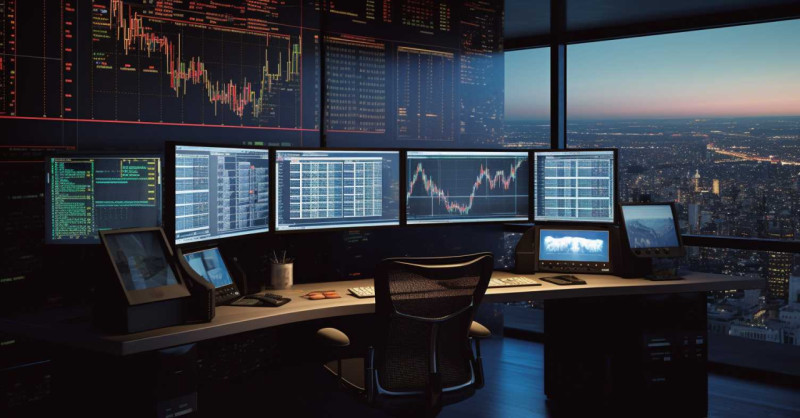
Introduction
The realm of stock trading is not just about numbers, intuition, and timely decisions; it's also about visual clarity and uninterrupted data access. Traders, whether novices or seasoned professionals, find themselves at the confluence of vast streams of information. Chart patterns, real-time stock prices, news feeds, and analytics dashboards all vie for attention simultaneously. In this dynamic landscape, the role of a good monitor becomes paramount.
At first glance, one might underestimate the importance of a monitor in a trader's success. However, having a screen that provides crisp visuals, offers ample screen real estate, and reduces eye strain can be a game-changer. It can mean the difference between spotting a rising stock trend in time or missing out on a profitable trade opportunity. As we delve deeper into the world of stock trading, we'll uncover why investing in the right monitor is not just an option but a necessity for those serious about their trading game.
In an era where precision and speed are paramount, the tools we utilize to interpret and act upon information can set the stage for success or failure. Nowhere is this truer than in the world of stock trading. Here, traders are constantly bombarded with a barrage of data, from fluctuating stock prices to intricate chart patterns. The significance of screen clarity, size, and resolution, therefore, cannot be overstated.
A monitor's clarity is akin to a microscope for a biologist; it allows traders to discern minute details that others might overlook, offering them a competitive edge. The size of the screen, meanwhile, acts as a canvas, accommodating multiple windows and streams of data, ensuring that a trader never misses out on crucial information. And finally, resolution is the fine brush that paints a clear picture of the data, allowing traders to swiftly and accurately interpret the market's movements.
When these three factors – clarity, size, and resolution – converge perfectly, they empower traders to make informed and timely decisions, maximizing opportunities and minimizing risks. In this exploration, we'll delve into why these monitor attributes are the linchpins in the demanding and fast-paced arena of stock trading.
Why is a Specialized Monitor Important for Stock Trading?
The role of technology in stock trading
In today's digital age, stock trading has evolved far beyond the noisy floors of stock exchanges with brokers shouting orders. Modern stock trading is a sophisticated endeavor, highly reliant on technology. From executing trades at lightning speed to analyzing vast amounts of data, technology has revolutionized how traders operate, and central to this technological ecosystem is the monitor.
Rapid Decision Making: Stock trading often requires split-second decisions. A specialized monitor with high clarity ensures that traders can instantly interpret data without any visual hindrance. The quicker the data is understood, the faster a trader can act, potentially making the difference between profit and loss.
Multi-Tasking Capabilities: Traders often juggle multiple tasks simultaneously – observing real-time stock prices, reading relevant news, analyzing charts, and executing trades. A specialized monitor, particularly those with larger screens, allows for efficient multi-window setups, ensuring that traders have all the necessary information at their fingertips.
Reduced Eye Strain: Trading often means long hours staring at the screen. Monitors designed for trading come with features like blue light filters, flicker-free technology, and adaptive brightness. These features not only ensure comfort but also reduce the risk of eye fatigue, which can lead to mistakes.
Precision in Data Visualization: Stock trading relies heavily on the analysis of charts, graphs, and other visual representations of data. A monitor with a high resolution ensures that these visuals are displayed crisply, aiding in more accurate analysis.
Enhanced Customization: Specialized monitors often come with advanced settings tailored for trading. For instance, they might offer customizable color settings to better differentiate between data points or support for specialized trading software.
In conclusion, while generic monitors might serve the purpose for casual computing tasks, stock trading requires a level of precision and efficiency that only specialized monitors can provide. As the role of technology in stock trading continues to grow, the importance of having the right monitor becomes even more pronounced, making it an indispensable tool in a trader's toolkit.
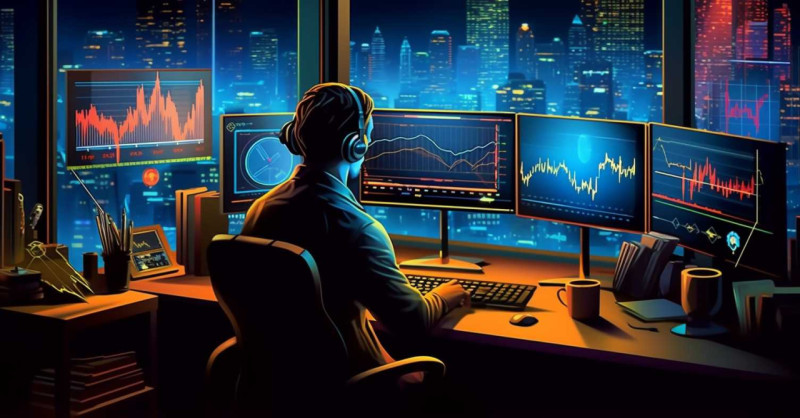
Comparison of General-use Monitors versus Specialized Trading Monitors
In the vast spectrum of digital screens available today, the distinction between general-use monitors and specialized trading monitors is pivotal, especially for professions that demand precision and efficiency, such as stock trading. While both types of monitors serve the purpose of display, their inherent designs and features cater to different needs.
Purpose & Design Philosophy
General-use monitors are conceived with versatility in mind. They're intended to serve the casual user or professional across a variety of tasks, from browsing the internet and streaming videos to basic office tasks like document editing or spreadsheet management. Their design emphasizes a balance between performance and affordability.
On the other hand, specialized trading monitors are crafted with a singular focus: to cater to the dynamic and data-intensive world of stock trading. They prioritize real-time data delivery, clarity, and multi-screen synergy – aspects crucial for traders.
Visual Performance
The visual performance of a monitor plays a key role in tasks that require close attention to detail. General-use monitors usually offer decent resolutions suitable for everyday tasks and some entertainment purposes. However, they might not always deliver the crispest visuals or fastest refresh rates.
Specialized trading monitors, in contrast, emphasize impeccable visual performance. They often come with higher resolutions and faster refresh rates. This ensures that stock charts, which can be dense with data and require rapid interpretation, are displayed clearly and in real-time.
Screen Real Estate & Configuration
A typical user might be content with a single screen or perhaps a dual-monitor setup for enhanced multitasking. General-use monitors are designed with this in mind, offering decent screen sizes and standard configurations.
For traders, screen real estate is invaluable. The ability to monitor multiple stocks, news feeds, and analytical tools simultaneously can make or break a trading decision. Specialized monitors cater to this by not only offering larger screens but also ensuring that multiple screens can be seamlessly integrated. They often come with ultra-thin bezels and are designed for multi-monitor configurations without visual disruptions.
Ergonomics & Eye Comfort
While most modern general-use monitors consider ergonomics and eye comfort, they might not always offer the best features in these areas. Basic adjustable stands and some level of blue light filtering could be expected.
Specialized trading monitors take this a step further. Given that traders spend extended hours staring at screens, these monitors incorporate advanced eye comfort technologies. Features like flicker-free displays, advanced blue light reduction, and highly adjustable stands for optimal viewing angles become standard.
While general-use monitors are versatile allies for a range of tasks, specialized trading monitors are the weapons of choice for stock traders. Their design and features are meticulously calibrated to offer traders the edge they need in the competitive and fast-paced world of stock trading. Investing in such a monitor is not just about having a screen; it's about equipping oneself with a tool that amplifies precision, efficiency, and success in trading.
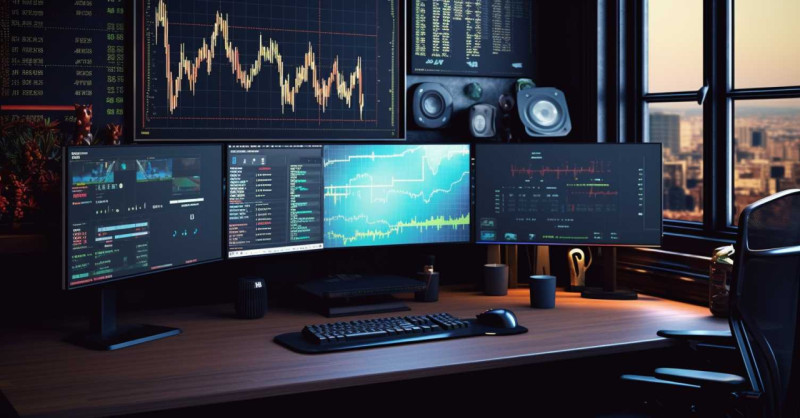
Importance of real-time data visualization
Real-time data visualization is a cornerstone of many modern industries, especially in sectors where timely decisions can lead to significant outcomes. By converting vast amounts of data into accessible, visual formats instantly, stakeholders can gain immediate insights, make informed decisions, and respond rapidly to changing situations. Let’s delve deeper into the importance of real-time data visualization.
In a world that's becoming increasingly data-driven, the sheer volume of information generated can be overwhelming. Traditional methods of data analysis, which involve poring over spreadsheets or waiting for periodic reports, are not only time-consuming but also risk missing out on real-time trends and anomalies.
Real-time data visualization addresses this challenge head-on. By offering a visual snapshot of live data, complex information is transformed into intuitive graphics that are easily digestible and actionable. This not only facilitates immediate comprehension but also empowers individuals and organizations to act swiftly.
For sectors like stock trading, e-commerce, or digital marketing, where market dynamics can change in a matter of seconds, real-time data visualization is invaluable. Stock traders, for instance, rely on it to monitor market movements, identify trading opportunities, and mitigate risks. A delay or lag in data representation can potentially translate into missed opportunities or even significant losses.
Furthermore, real-time visualization tools often come with interactive features, allowing users to drill down into specific data points, adjust parameters, or switch between different data sets on-the-fly. This dynamic interaction fosters a deeper understanding and enables more nuanced decision-making.
Additionally, real-time data visualization enhances collaboration. Teams spread across different locations can simultaneously view and interpret the same live data, ensuring everyone is on the same page and facilitating synchronized action.
Lastly, in crisis management or emergency response scenarios, real-time data visualization can be lifesaving. Whether monitoring natural disasters, tracking the spread of diseases, or overseeing critical infrastructure, having an instant visual representation allows for prompt interventions, resource allocations, and strategic planning.
In conclusion, real-time data visualization is more than just a technological advancement; it's a paradigm shift in how we perceive, interpret, and act upon information. By turning complex data into visual stories as events unfold, it ensures that individuals and organizations are not just spectators but active, informed participants in the ever-evolving narrative of the modern world.
Key Features to Consider
Screen Size and Resolution
One of the first considerations when selecting a monitor for stock trading or any data-intensive task is the screen size and resolution. Both these aspects play a pivotal role in determining the user's experience, efficiency, and overall effectiveness in the trade.
When it comes to stock trading, the adage "bigger is better" often rings true. A larger screen size provides traders with more visual real estate. This is essential as traders frequently need to track multiple stocks, charts, news feeds, and other relevant data simultaneously. With a larger screen, traders can comfortably have multiple windows open side-by-side, reducing the need to toggle between tabs or software. This seamless access to various data points allows traders to make more informed decisions quickly, which is crucial in the fast-paced world of stock trading.
However, screen size alone isn't enough. The clarity of the displayed data is equally vital, and this is where resolution comes into play. Resolution refers to the number of pixels a screen has in its width by height. Higher resolution means more pixels, which translates to sharper and clearer images. For stock traders, a high-resolution monitor ensures that the intricate details of stock charts, graphs, and texts are crisply displayed. When monitoring the minute fluctuations in stock prices or discerning patterns in complex charts, a high-resolution display ensures that no detail is missed.
Optimal resolutions like Full HD (1920x1080), Quad HD (2560x1440), or even 4K (3840x2160) are becoming increasingly popular among traders. The choice largely depends on the trader's specific needs and the size of the monitor. For instance, a 27-inch monitor might benefit more from a Quad HD resolution to maintain clarity, while a larger 32-inch or above could utilize 4K for optimal visuals.
In essence, while size provides the canvas, resolution dictates the clarity of the picture. Both are paramount for traders who rely on precise data visualization for success. When coupled together, a large screen with high resolution becomes a powerful tool, enabling traders to stay ahead in the game with unmatched clarity and efficiency.
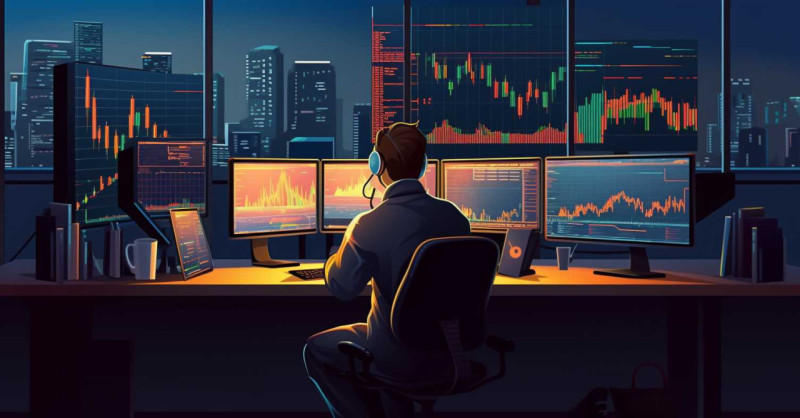
Refresh Rate
In the realm of monitor specifications, while screen size and resolution often steal the spotlight, the refresh rate remains a vital feature, especially for tasks demanding real-time data monitoring like stock trading. Understanding its significance begins by decoding what it actually means.
The refresh rate of a monitor is defined as the number of times it updates with new information per second. It's measured in hertz (Hz), so a monitor with a refresh rate of 60Hz updates the display 60 times in one second. On the surface, this might seem like a technical detail pertinent only to gamers or video editors, but its relevance in the stock trading world is profound.
Stock markets are dynamic, with prices and indices constantly fluctuating. For traders, having the latest data at their fingertips is crucial. A higher refresh rate ensures that the displayed data on the monitor is updated more frequently, presenting almost real-time information. This becomes especially significant during volatile market periods, where stock prices can change rapidly within fractions of a second. A monitor with a higher refresh rate will display these changes more smoothly and accurately, ensuring traders are always informed of the most recent developments.
Consider a scenario where two traders are monitoring a highly volatile stock, one using a 60Hz monitor and the other a 144Hz monitor. The trader with the 144Hz monitor will perceive price changes more than twice as fast as the one with the 60Hz display. In the world of stock trading, where decisions are often made in split seconds, this advantage can be the difference between capitalizing on an opportunity and missing it entirely.
Moreover, beyond just stock prices, higher refresh rates also improve the overall user experience. The smoothness in transitions, animations, and cursor movements makes prolonged use less straining on the eyes and ensures that any visual tools or charts used in analysis are displayed seamlessly.
In conclusion, the refresh rate is more than just a number in a spec sheet for traders. It's a direct reflection of how quickly and smoothly they receive critical market updates. In a profession where timely decisions can lead to significant financial implications, ensuring real-time stock monitoring through a higher refresh rate becomes an indispensable asset.
Connectivity Options
Modern trading stations aren't just about the computer and the monitor. They encompass an ecosystem of devices working in harmony, from secondary displays and data feed devices to peripherals like mice, keyboards, and even tablets for quick data input. Central to integrating all these devices seamlessly is the monitor's connectivity options, particularly its HDMI, DisplayPort, and USB ports.
HDMI and DisplayPort are standard video interfaces. While both can transmit HD video and audio from a PC to the monitor, they serve slightly different needs. HDMI is ubiquitous and can be found in most laptops, desktops, and even tablets. It's versatile, supporting both video and audio, making it suitable for traders who might also use their setups for multimedia purposes. DisplayPort, on the other hand, is a newer connector primarily designed for computer displays. It can support larger screen sizes with higher resolutions and refresh rates compared to HDMI. This makes DisplayPort especially valuable for traders who opt for larger, high-resolution monitors to track multiple stocks simultaneously. Additionally, certain versions of DisplayPort support daisy chaining, which allows multiple monitors to be connected in sequence using a single connection to the computer.
Multiple ports of both HDMI and DisplayPort on a monitor not only offer flexibility in terms of the devices and computers you can connect but also pave the way for multi-monitor setups. For traders, this is invaluable. Being able to spread their workspace over two or more screens can drastically enhance efficiency, allowing for better multitasking and a more organized trading environment.
Then there are USB ports, which have evolved into much more than just connectivity solutions for peripherals. With the advent of USB Type-C, monitors now can receive video input, transmit data, and even supply power using a single cable. For traders, this can simplify their setup, reducing cable clutter, and providing a more streamlined workstation. Moreover, having multiple USB ports means easy access for connecting other essential devices like flash drives, mobile phones, or even external data sources without reaching for the computer.
In essence, when evaluating monitors for stock trading, it isn't just the display quality that matters. A monitor's connectivity options form the backbone of an efficient trading workstation. They ensure that all devices work in concert, that there's room for expansion, and that the trader is always equipped to adapt to the ever-evolving technological landscape of stock trading.
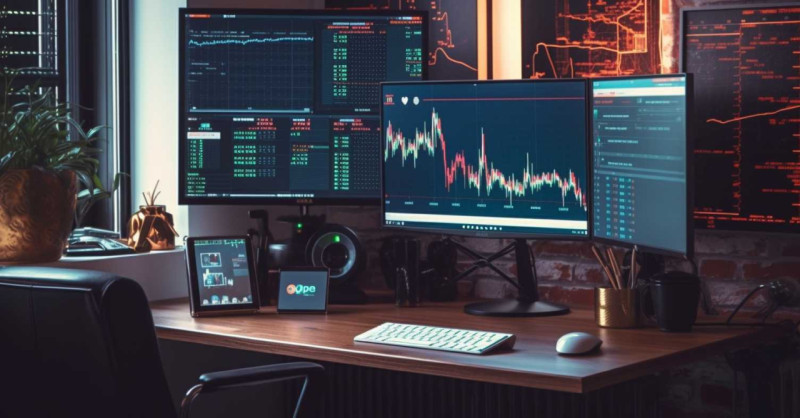
Bezel-Less Design
The aesthetics of a monitor might seem secondary to its performance metrics, but when we discuss bezel-less design, it transcends mere aesthetics and ventures into the domain of functionality, especially in the context of stock trading.
Bezel-less monitors, as the name suggests, minimize the thick borders or 'bezels' traditionally seen around the screen. The result is a display that seems to stretch from edge to edge, providing an uninterrupted visual experience. But beyond the contemporary look it brings to a workspace, how does this design influence the life of a stock trader?
Multi-monitor setups have become almost a rite of passage for serious stock traders. They allow traders to monitor multiple data streams simultaneously – from tracking several stocks, watching news feeds, analyzing charts, to executing trades. Each screen can be dedicated to a particular task, or multiple screens can together display a vast array of data in a grid format. Now, imagine placing two or more traditional monitors side by side. The bezels create a visual break, a gap that can disrupt the flow of information and divert attention.
Enter bezel-less monitors. When these are placed side by side in a multi-monitor setup, the absence of thick bezels ensures that the visual transition from one screen to another is almost seamless. This continuous visual flow is vital for traders who are comparing data across screens or who wish to stretch a single application or chart over multiple displays. Without bulky bezels in the way, the information feels more connected, providing a panoramic view of data.
But it's not just about the unbroken visual experience. A bezel-less design also means efficient use of desk space. With the screen stretching closer to the monitor's edges, traders can enjoy a larger display without significantly increasing the monitor's footprint. This is a boon for those who have limited workspace but need the advantage of multi-monitor setups.
In the rapid-paced world of stock trading, where every second counts, distractions are a luxury one can't afford. A bezel-less design, though seemingly a simple innovation, can dramatically enhance a trader's efficiency, providing an expansive, uninterrupted view of the markets. It's a testament to how even design elements, often seen as mere cosmetic enhancements, can play a pivotal role in the effectiveness and success of a professional.
Adjustability & Ergonomics
Engaging with the stock market doesn't just demand mental agility and financial acumen; it also requires a physical setup that can support the long hours and intense focus. Traders often find themselves in front of their screens for extended periods, making the ergonomics of their workstation not just a matter of comfort but also of health and productivity. This is where the adjustability features of a monitor, such as tilt, swivel, pivot, and height adjustments, become paramount.
The ability to tilt a monitor helps in achieving the optimum viewing angle. A slight upward or downward adjustment can significantly reduce the chances of neck strain, allowing traders to maintain a neutral posture. It's crucial for traders who, during intense trading sessions, might lean in closer to their screens or recline in their chairs – a tilt-adjustable monitor can be aligned to their line of sight effortlessly.
Swivel functionality is a boon, especially in dynamic workspaces. It allows the monitor to rotate horizontally, making it easier to share content with a colleague or simply adjust based on seating shifts. For traders who frequently collaborate or need to shift their attention between multiple work areas, this feature ensures the monitor is always facing them squarely, preventing any awkward viewing angles.
Pivot adjustment takes versatility to a whole new level. By letting the monitor rotate from a horizontal (landscape) to vertical (portrait) orientation, traders get an added layer of flexibility in how they display content. Stock charts, for instance, can sometimes benefit from a vertical view, presenting longer time frames or more detailed price information.
Height adjustment, arguably one of the most critical ergonomic features, lets users set the monitor at an ideal eye level. A monitor positioned too low or too high can lead to chronic neck and back pains. By ensuring the top of the screen is at or slightly below eye level, traders can maintain a natural head position, making those long trading sessions more bearable and reducing the risk of postural issues.
Beyond just comfort, proper ergonomics directly impact efficiency and focus. A workstation tailored to the trader's physical needs means fewer distractions from discomfort, allowing them to stay immersed in the markets. In the long run, the benefits also extend to overall well-being, preventing the onset of issues like computer vision syndrome, repetitive strain injuries, or musculoskeletal problems.
In essence, as the world of stock trading increasingly leans on technology, ensuring that this technology is aligned, quite literally, to the trader's well-being becomes indispensable. Adjustable and ergonomic monitor designs acknowledge and address this, blending health and functionality seamlessly.
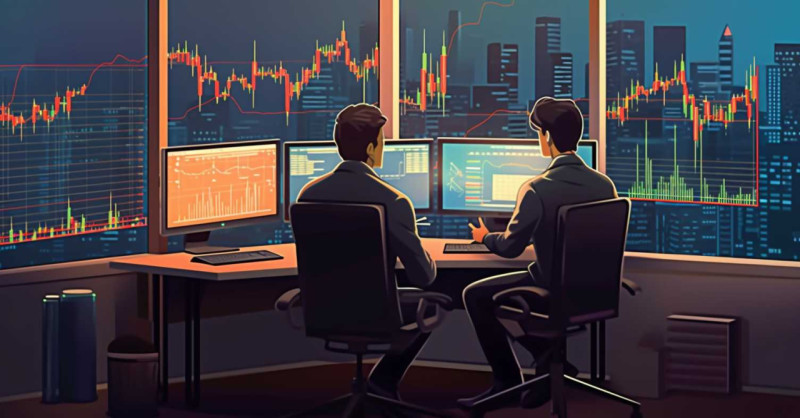
Color Accuracy & Consistency
In the visual landscape of stock trading, where charts and graphs dominate, color isn't just an aesthetic choice – it's a functional tool. Each color can represent a specific trend, indicator, or data point. As such, the accuracy and consistency of colors displayed on a monitor become crucial in ensuring that traders get a clear, unambiguous view of the market's movements.
Color accuracy refers to a monitor's ability to reproduce colors as they are intended, matching them as closely as possible to the original source or a specific standard. In the context of stock trading, this means that when a chart uses green to indicate rising stock prices or red for falling ones, these colors are displayed precisely as they should be. A slight deviation in shade might cause confusion, potentially leading to misinterpretation of data. Imagine interpreting a pale red as a slight dip when, in fact, it indicates a significant market downturn. The financial implications of such misunderstandings can be substantial.
Furthermore, consistency plays a pivotal role alongside accuracy. It's not just about displaying the correct color but ensuring that the color remains consistent across the entire screen and over time. Inconsistent color representation might mean that the same shade of blue, indicating a specific data parameter, looks slightly different on the left side of the screen compared to the right. For traders who rely on split-second decisions, such inconsistencies can be distracting and might even lead to errors in judgment.
Beyond just the basic colors, many trading platforms and software utilize a myriad of shades and hues to differentiate between various data points, overlays, indicators, and trends. An accurate and consistent color representation ensures that each of these is distinct and easily distinguishable, even when displayed side by side.
Moreover, with the growing use of advanced graphical analysis in stock trading, where heat maps, candlestick patterns, and intricate overlays are common, color differentiation becomes even more critical. A monitor with high color accuracy ensures that traders can discern even the subtlest color-coded nuances in their data visualizations.
In conclusion, while specs like resolution, refresh rate, and size often take center stage when choosing a monitor for stock trading, color accuracy and consistency are unsung heroes that can dramatically influence a trader's efficiency and accuracy. Investing in a monitor that excels in these areas ensures that the colorful world of stock charts is not just vivid but also unerringly precise, aiding traders in making informed and timely decisions.
Top 5 Monitors for Stock Trading in 2023
In the digital age, the right tools can significantly enhance a trader's experience and efficiency. Among these tools, a high-quality monitor stands out as a vital piece of equipment. As 2023 unfolds, several monitors have risen to prominence, particularly tailored to meet the demands of stock trading. Here's a look at the top 5 monitors that have been making waves this year:
Dell UltraSharp Series: Known for its excellent color accuracy and premium build quality, the Dell UltraSharp monitors, especially those with 4K resolution, have been a favorite for professionals across different fields.
LG UltraFine: Especially the 4K and 5K variants, these monitors offer excellent clarity, brightness, and color fidelity. They are equipped with USB-C connectivity, making them suitable for modern setups.
ASUS ProArt Series: ASUS's ProArt monitors are designed for professionals needing high color accuracy and consistency. They usually come factory-calibrated, ensuring top-notch visual performance right out of the box.
Acer Predator X27: Though primarily marketed towards gamers, this monitor boasts specs that make it suitable for trading as well. With a 4K UHD resolution, high refresh rates, and NVIDIA G-SYNC, it ensures smooth visuals.
Samsung Odyssey G9: This ultra-wide, curved gaming monitor provides ample screen real estate and sharp visuals, which can be beneficial for traders looking to track multiple stocks or data points simultaneously.
When considering a monitor for stock trading, or any professional work, it's crucial to prioritize features that align with one's specific needs, such as resolution, color accuracy, refresh rate, and ergonomic design. Always remember to check recent reviews and product specifications before making a purchase decision.
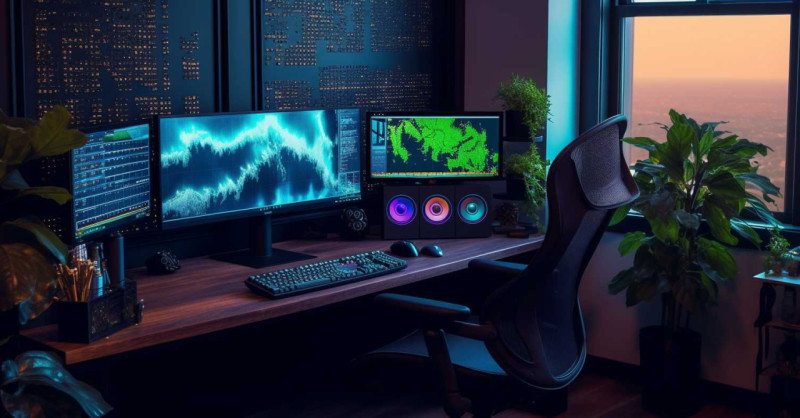
The Advantages of a Multi-Monitor Setup
The fast-paced, intricate world of stock trading demands quick access to information and an efficient workflow. While a single monitor might suffice for casual traders or those just starting out, many seasoned professionals swear by a multi-monitor setup. Let's delve into the compelling advantages of such a configuration:
Enhanced Multitasking: At any given moment, a trader might be monitoring real-time stock prices, examining detailed charts, watching financial news, and executing trades. A multi-monitor setup allows each of these activities to have its dedicated screen, facilitating swift transitions between tasks without the need to constantly toggle between windows or tabs.
Comprehensive Data Visualization: Traders heavily rely on charts, graphs, and other visual data representations. Having multiple monitors allows for simultaneous viewing of different datasets or multiple timeframes of the same stock. For instance, one screen can display a stock's daily chart, another its hourly movements, while a third might be reserved for a broader market overview.
Reduction in Errors: In trading, mistakes can be costly. Navigating a cluttered single screen increases the risk of oversight or misinterpretation. By spreading out the information across multiple screens, traders can organize their workspace more effectively, reducing the chances of errors arising from misreading or overlooking crucial data.
Increased Productivity: With everything in clear view, traders can respond more rapidly to market changes. Instead of wasting time resizing windows or searching through minimized applications, they can focus solely on making informed decisions based on the data presented across their screens.
Flexible Workspace Customization: Every trader has a unique approach and preference. Multiple monitors offer the flexibility to customize the workspace to one's individual needs. For instance, some might prefer having a dedicated monitor for news feeds, while others might prioritize charting software or communication tools.
Enhanced Engagement: A multi-monitor setup can provide a more immersive experience. Instead of being confined to a limited screen space, traders can surround themselves with vital information, fostering deeper engagement and focus on the market's intricacies.
Future-Proofing: As trading platforms and software continue to evolve, they often introduce new features, tools, and visual elements. Having a multi-monitor setup ensures that traders can seamlessly incorporate these innovations into their workflow without feeling restricted by screen space.
In conclusion, while the initial investment in a multi-monitor setup might seem substantial, the potential boosts in efficiency, accuracy, and productivity make it a worthy consideration for those serious about trading. As technology continues to advance and the world of stock trading becomes even more complex, the advantages of multiple screens will only become more pronounced.
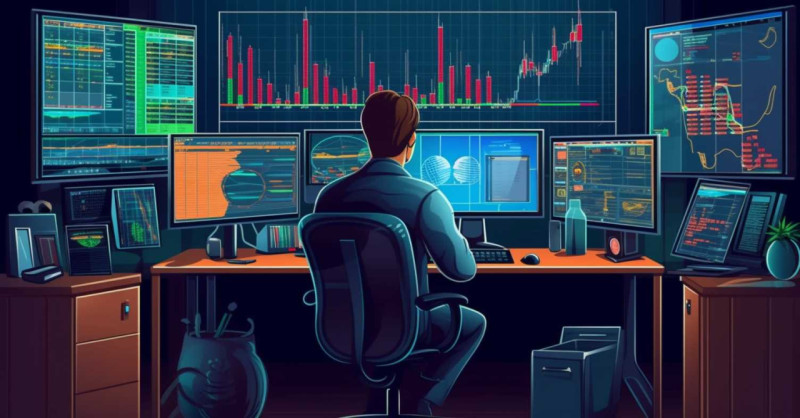
The Role of Software in Stock Trading Monitors
While having an optimized monitor setup can profoundly impact a trader's experience, the software running on these screens is equally, if not more, vital. It's the bridge between the trader and the vast ocean of market data, facilitating analysis, decision-making, and trade execution. Let's explore the crucial interplay between stock trading monitors and software:
Importance of Pairing Your Monitor with the Right Trading Software:
A monitor, no matter how advanced, is only as effective as the software it displays. The right trading software can leverage the monitor's features, ensuring traders can access, view, and interpret data seamlessly. High-resolution monitors, for instance, are best paired with software that offers sharp chart visualizations, while multi-monitor setups benefit from software that supports multiple windowed views.
Furthermore, traders have diverse needs based on their trading style, market of interest, and analysis techniques. Scalpers, day traders, and long-term investors might prioritize different software features. Hence, pairing the monitor with tailored trading software can significantly enhance one's trading efficiency and precision.
Recommendations for Best Stock Trading Software Platforms in 2023:
Thinkorswim by TD Ameritrade: Highly customizable and packed with powerful analytical tools, Thinkorswim has remained a top choice for both beginners and experienced traders.
MetaTrader 4 & 5: Especially popular among Forex traders, the MetaTrader platforms offer advanced charting tools, automated trading capabilities, and a vast marketplace of plugins.
Interactive Brokers' Trader Workstation (TWS): Recognized for its advanced tools and extensive market access, TWS caters to professional traders and institutional investors.
NinjaTrader: Known for its robust charting and backtesting capabilities, NinjaTrader is a favorite for futures traders.
eSignal: A comprehensive trading platform offering advanced charting, real-time news, and direct market access.
Tips for Optimizing Software Settings for Your Specific Monitor:
Resolution Matching: Ensure the software's resolution settings align with your monitor's native resolution for the clearest visuals.
Utilize Grid Views: Many platforms allow users to set up grid views. This can be especially helpful on wider or larger monitors to view multiple charts or data points simultaneously.
Adjust Font Sizes and Chart Elements: On high-resolution monitors, some elements might appear too small. Customize font sizes, chart lines, and other visual elements to make them comfortably readable.
Leverage Multi-Monitor Features: If the software supports it, spread your workspace across screens. For example, keep your main trading dashboard on one screen, charts on the second, and news or other auxiliary tools on the third.
Regular Updates: Always ensure your software is up-to-date. Developers often release optimizations for newer monitor tech, bug fixes, and feature enhancements.
In sum, while the hardware lays the foundation, it's the marriage of monitors and software that defines a trader's digital environment. Investing time in selecting and optimizing the right software can dramatically elevate the trading experience, paving the way for more informed and timely market decisions.

Budget-Friendly Options
The stock trading realm often conjures images of high-end setups with multiple gleaming screens displaying intricate data. But not every trader requires, or can afford, the creme de la creme of monitors. Thankfully, technological advancements have ushered in a generation of budget-friendly monitors that don't skimp on essential features. Let's explore these cost-effective champions and see how they compare with their premium counterparts.
Highlighting Monitors That Deliver Great Value Without Breaking the Bank:
While the market sees continual evolutions and releases, as of 2023, several monitors offered commendable features at attractive price points:
Acer R240HY: This 23.8-inch monitor boasts an IPS panel, which ensures vibrant colors and wide viewing angles. Its thin bezels and 1080p resolution make it a solid choice for traders just starting out.
BenQ GW2270: A 21.5-inch monitor with a 1080p VA panel. It's known for its good contrast ratio and eye-care technology, minimizing strain during long trading sessions.
ASUS VA24EHE: Standing at 23.8 inches, this monitor features an IPS panel, adaptive-sync technology, and a 75Hz refresh rate, providing smooth visuals and decent color reproduction.
Comparison of Features Between High-End and Budget Monitors:
Resolution & Clarity: High-end monitors often offer 4K or even 8K resolutions, ensuring maximum clarity. Budget monitors typically cap at 1080p, which is still sufficient for many trading tasks, but might lack the crispness of higher resolutions.
Refresh Rate: Premium monitors might boast refresh rates of 120Hz or higher, providing ultra-smooth visuals. Budget-friendly options usually hover around 60Hz to 75Hz, which is adequate for trading but might not have the same fluidity.
Color Accuracy: Top-tier monitors focus heavily on color accuracy, vital for graphic designers and video editors. While this might not be paramount for traders, having accurate color representation can still aid in reading charts and graphs. Budget monitors, especially those with IPS panels, offer decent color accuracy, but might not match the standards of high-end models.
Connectivity: High-end monitors often come equipped with a plethora of ports, from multiple HDMI and DisplayPort inputs to USB-C and even built-in KVM switches. Budget monitors might have fewer ports, but they typically still cover essential connectivity needs.
Ergonomics & Adjustability: Premium monitors tend to offer extensive adjustability, from tilt and swivel to height and pivot adjustments. Some budget monitors might have fixed stands, but many still offer basic tilt functions.
Extra Features: High-end monitors might come with additional perks like built-in speakers, blue light filters, or adaptive sync technologies. While these can be found in some budget monitors, they might not be as prevalent or advanced.
In conclusion, the world of stock trading monitors presents a vast spectrum of choices, catering to both the premium seekers and the budget-conscious. While high-end monitors undeniably offer a luxurious experience and advanced features, it's heartening to note that budget-friendly options have come a long way. They now provide a reliable and efficient trading environment, ensuring that the market remains accessible to enthusiasts regardless of their financial bracket.
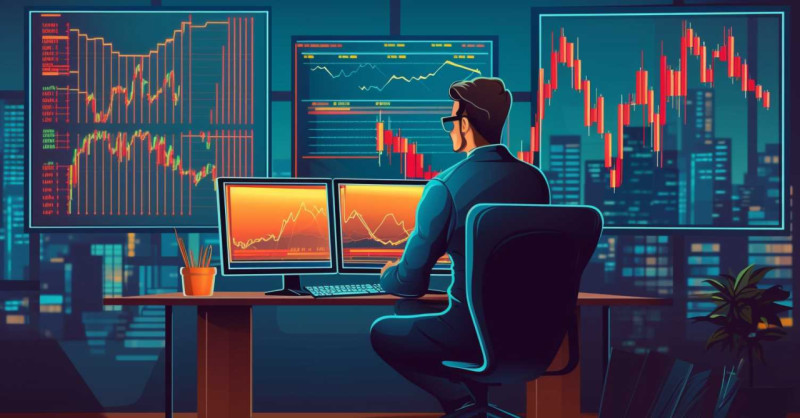
Conclusion
Navigating the intricate pathways of the stock trading world is a journey of strategy, foresight, and timely decision-making. Integral to this experience is the digital interface traders interact with – the monitor. Throughout this exploration, we've seen how the right monitor can profoundly influence trading outcomes, from real-time data visualization to multitasking prowess.
It's not merely about picking the most premium or the latest model on the market. It's about understanding the symbiotic relationship between the trader and the technology. The right monitor, whether it's a high-end marvel with exceptional resolution and color accuracy or a budget-friendly workhorse that delivers on essentials, can significantly enhance clarity, reduce errors, and facilitate quicker responses.
But as with many things in trading, it boils down to individual needs. A day trader scalping on minute charts has different monitor requirements compared to a long-term investor examining broader market trends. This underscores the importance of introspection: understanding one's trading style, strategies, and daily routines.
Therefore, as you stand at the crossroads of making a decision, weigh the myriad features against your personal trading needs. Consider the resolution, refresh rates, connectivity options, and, yes, even the ergonomics. Remember, in the world of stock trading, where seconds can sometimes translate into significant gains or losses, the right monitor is not just a peripheral—it's a partner in your pursuit of financial growth.
To all our readers: may you find the monitor that not only complements your trading style but also elevates your market journey to new pinnacles of success and satisfaction. Happy trading!





